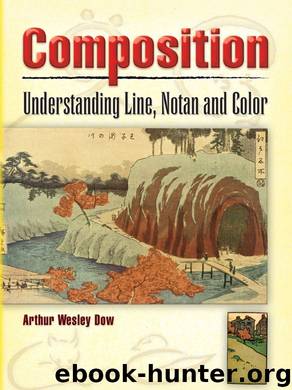Composition by Arthur Wesley Dow

Author:Arthur Wesley Dow
Language: eng
Format: epub
ISBN: 9780486133645
Publisher: Dover Publications
Published: 2012-07-18T04:00:00+00:00
Note.—These two sketches and one on p. 96 are from a XVIIth century Japanese book
COLOR
XIV.—COLOR THEORY
COLOR, with its infinity of relations, is baffling ; its finer harmonies, like those of music, can be grasped by the appreciations only, not by reasoning or analysis. Color, in art, is a subject not well understood as yet, and there are violent differences of opinion among artists, teachers and critics, as to what constitutes good color-instruction. The most that I can do here is to outline a simple method of study. The usual advice of the academic painter to “ keep trying,” is discouraging to the beginner and increases his confusion ; it is not in accord with good sense either, for the other arts are not attacked through timid and aimless experiment. An artist may say that a certain group of colors is a harmony; the pupil cannot see it, but he takes the master’s word for it. The artist is not teaching successfully unless he points the way to appreciation, however hard or long it may be.
A systematic study of line and tone is very profitable, as we have seen ; I believe that color may be approached in like manner, and I shall attempt now to relate the treatment of the color-element (chapter I) to that of the other two, and to give some results of personal experience.
Those who have but little time for work in color, can spend it best in copying, under guidance, examples of acknowledged excellence, like Japanese prints, Oriental rugs, and reproductions of masterpieces. Contact with these, even looking at them (if the pupil is taught what to look for), will strengthen the powers of color perception. In schools where the art periods are short and few, this may be the only method possible. (See p. 13 and chap. XVI.)
For those who intend to use color in creative work a certain amount of theory is indispensable, as it simplifies the subject and opens up a few definite lines of research. The word “theory ” has become a kind of academic bugbear, yet Leonardo da Vinci said that the painter who works without a theory is like the sailor who goes to sea without a compass. Well-ordered thought is as necessary in art as in any other field. Theory is a help to clear thinking and gives direction and purpose to practice.
Color, however complicated, may be reduced to three simple elements:
HUE,—as yellow, blue-green,
NOTAN (or Value),—as dark red, light red,
INTENSITY (or Bright-to-grayness) —as intense blue, dull blue.
Download
This site does not store any files on its server. We only index and link to content provided by other sites. Please contact the content providers to delete copyright contents if any and email us, we'll remove relevant links or contents immediately.
Adulting by Kelly Williams Brown(4523)
Drawing Cutting Edge Anatomy by Christopher Hart(3475)
Figure Drawing for Artists by Steve Huston(3399)
Draw Your Day by Samantha Dion Baker(3311)
Drawing Shortcuts: Developing Quick Drawing Skills Using Today's Technology by Leggitt Jim(3029)
Make Comics Like the Pros by Greg Pak(2877)
Rapid Viz: A New Method for the Rapid Visualization of Ideas by Kurt Hanks & Larry Belliston(2863)
0041152001443424520 .pdf by Unknown(2809)
How Proust Can Change Your Life by Alain De Botton(2766)
How The Mind Works by Steven Pinker(2760)
Draw to Win: A Crash Course on How to Lead, Sell, and Innovate With Your Visual Mind by Dan Roam(2753)
Day by Elie Wiesel(2742)
Draw-A-Saurus by James Silvani(2680)
Tattoo Art by Doralba Picerno(2616)
Modern Cartooning by Christopher Hart(2583)
Learn Drawing Quickly by Sharon Finmark(2544)
Poses for Artists Volume 2 - Standing Poses: An essential reference for figure drawing and the human form. (Inspiring Art and Artists) by Justin Martin(2530)
Drawing and Painting Birds by Tim Wootton(2467)
Poses for Artists - Dynamic & Sitting: An essential reference for figure drawing and the human form (Inspiring Art and Artists Book 1) by Justin R Martin(2451)
